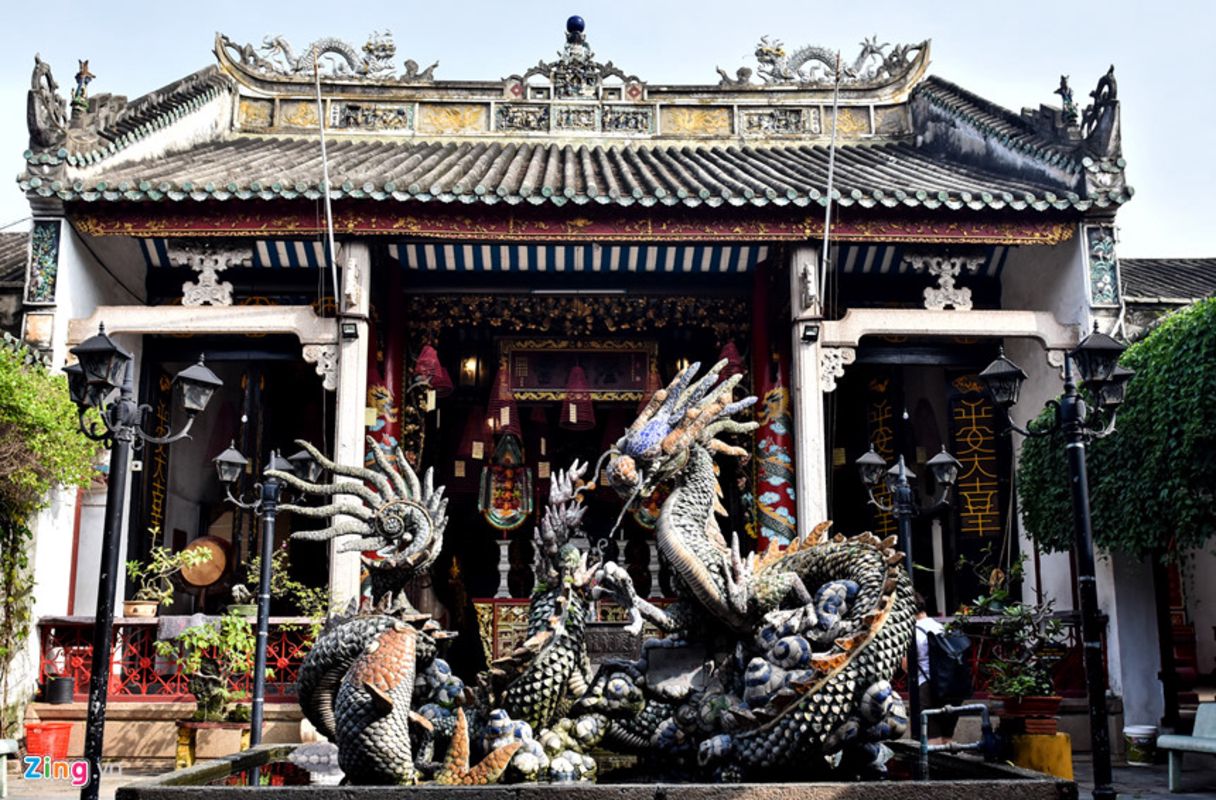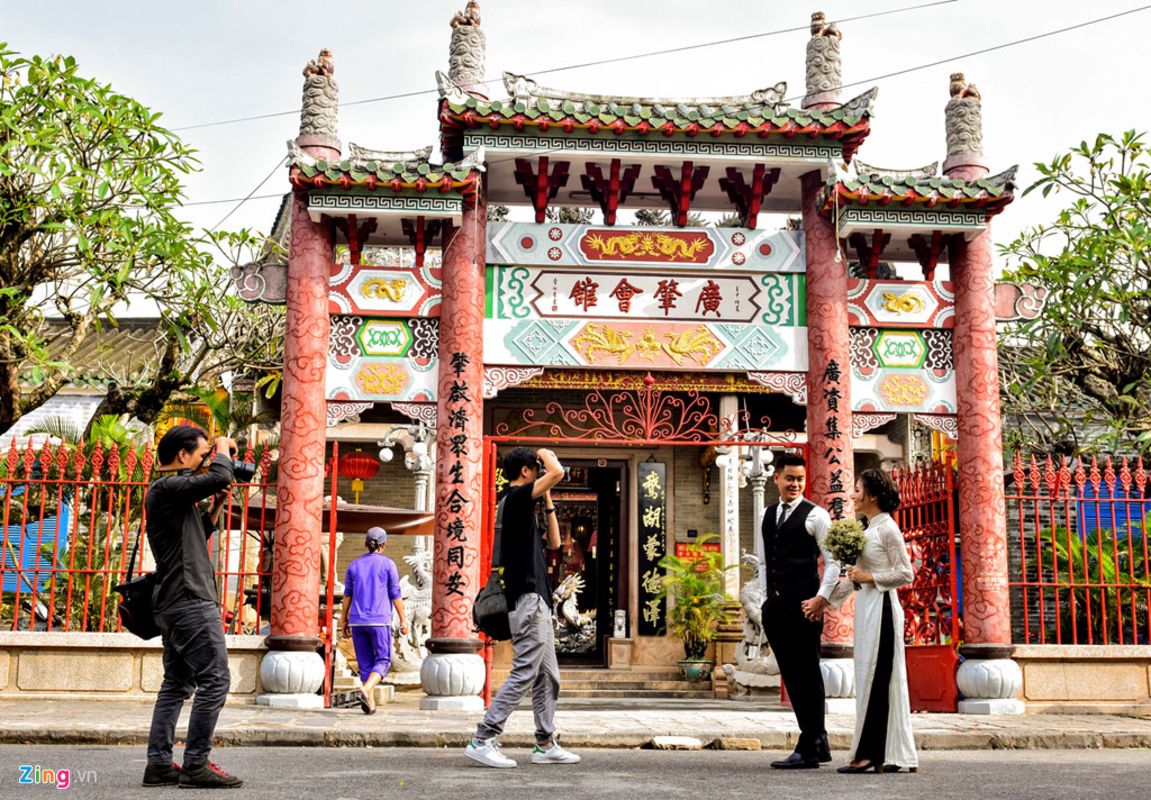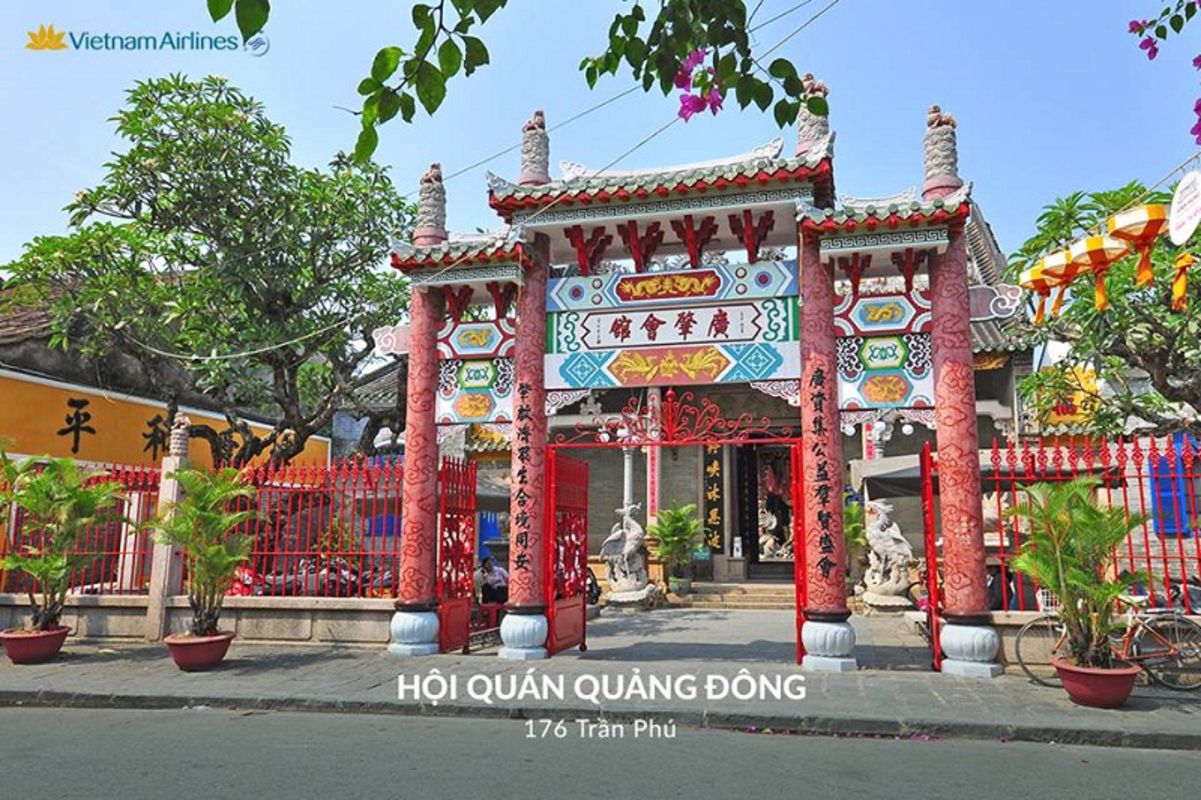Explore Cantonese Assembly Hall in Hoi An, Da Nang City! Discover its rich history, stunning architecture, festival dates, tour prices, and sustainable travel tips for this UNESCO site. Book your cultural tour today!
Hoi An Ancient Town, now a ward of Da Nang City following the merger of Quang Nam Province, is a UNESCO World Heritage Site celebrated for its vibrant history and architectural splendor. Nestled at 176 Tran Phu Street, the Cantonese Assembly Hall, also known as Quang Trieu Assembly Hall or Ong Pagoda, stands as a cultural jewel, drawing thousands of the town’s 4.5 million annual visitors. Built in 1885 by Cantonese merchants from Guangdong, China, this hall blends Chinese and Vietnamese architectural styles, offering a glimpse into Hoi An’s 15th–19th-century trading port legacy. With its ornate dragon carvings, sacred Quan Cong altar, and vibrant festivals, the hall is a must-visit for history enthusiasts and cultural explorers. Legend Travel Group, a leader in sustainable tourism, curates eco-friendly tours to immerse you in this historic site, bookable via links throughout this guide. Step into Hoi An’s past—reserve your tour now
Legend Travel Group delivers authentic Southeast Asia experiences, prioritizing sustainability and cultural immersion. Our Hoi An tours feature low-impact transport like bicycles and electric shuttles, guided by local experts who share the hall’s Cantonese heritage. We support Minh An’s community and align with Da Nang City’s “Heritage for Future” initiative to preserve sites like Cantonese Assembly Hall. With transparent pricing, free cancellations up to 48 hours before departure, and 24/7 support, we ensure a seamless journey. Explore the hall responsibly with our curated tours—book via the links on this page!
The Cantonese Assembly Hall, or Hội Quán Quảng Đông, is a testament to Hoi An’s multicultural history as a bustling trading port from the 15th to 19th centuries. Constructed in 1885 by Cantonese merchants, its components were crafted in China, shipped to Hoi An, and assembled into a majestic structure shaped like the Chinese character “囯” (nation). Initially dedicated to Mazu (Thien Hau Thanh Mau), the sea goddess, and Confucius, the hall shifted in 1911 to worship Quan Cong (Guan Yu), a revered Chinese general symbolizing loyalty and righteousness, alongside Guangdong sages. Beyond spiritual worship, it served as a community hub for Cantonese traders to network, exchange goods, and support each other, reflecting Hoi An’s role as a melting pot of Chinese, Vietnamese, and global influences.
Architecturally, the hall is a stunning blend of Chinese and Vietnamese elements, featuring a stone three-entrance gate adorned with dragons, phoenixes, and unicorns, roofed with green yin-yang tiles. The courtyard boasts a mosaic dragon fountain symbolizing power and prosperity, while the main hall houses a 40 cm bronze Quan Cong statue, flanked by altars for the God of Wealth (Tai Bach Tinh Quan) and God of Land (Phuoc Duc Chanh Than). Preserved artifacts, including four lacquered boards, a 1.6-meter bronze censer, and Chinese celadon porcelain pedestals, offer insights into the Cantonese community’s life. The backyard, with its spacious garden and second dragon fountain, provides a serene retreat. Recognized as part of Hoi An’s UNESCO site since 1999, the hall is a cultural landmark open daily from 6:00 AM to 4:00 PM.
 Photograph the historic allure of Da Nang’s heritage (Source: Internet)
Photograph the historic allure of Da Nang’s heritage (Source: Internet)Quang Nam Province has merged into Da Nang City, making Hoi An a ward under Da Nang City’s administration. This restructuring eliminates the district level, but Hoi An’s UNESCO status and the Cantonese Assembly Hall’s cultural significance remain intact. Da Nang City aims to promote Hoi An as a “Global Cultural Ward,” enhancing sustainable tourism with improved pedestrian pathways and eco-friendly infrastructure.
 Experience Da Nang Tours with sustainable exploration (Source: Internet)
Experience Da Nang Tours with sustainable exploration (Source: Internet)Marvel at the hall’s Chinese-Vietnamese architecture, from the ornate three-entrance gate with dragon carvings to the main hall’s vibrant Quan Cong altar and intricate pillars. The dragon fountains in the front and back courtyards symbolize prosperity.
Cost: Included in Hoi An Ancient Town ticket ($6/adult, 150,000 VND; covers 5 of 21 attractions); $4 (100,000 VND) for Vietnamese visitors; free for children under 16.
Highlights: “A stunning cultural blend” (Tripadvisor, 4.6/5 stars).
Tip: Visit mid-morning (8:00–10:00 AM) for fewer crowds; avoid running or loud noises. Included in our Hoi An Heritage Tour ($70–$90).
Discover preserved treasures like four lacquered boards, a 1.6-meter bronze censer, and celadon porcelain pedestals, reflecting Cantonese life in 19th-century Hoi An. Informational plaques detail the community’s trading history.
Cost: Included in Ancient Town ticket ($6).
Highlights: “A time capsule of Cantonese culture” (Vietnam Tourism).
Tip: Use QR codes for digital artifact guides; no photography in the shrine area. Included in our Hoi An Cultural Tour ($75–$95).
Join the vibrant Lantern Festival (Nguyen Tieu) on the 15th day of the first lunar month (typically February), featuring prayers, lanterns, and community gatherings to honor Quan Cong and pray for prosperity.
Cost: Free; donations $0.50–$2 (12,500–50,000 VND) appreciated.
Highlights: “A cultural spectacle” (Tripadvisor, 4.7/5 stars).
Tip: Book tours 3–4 weeks ahead for festival dates; dress modestly. Included in our Hoi An Festival Tour ($65–$85).
Experience the Quan Cong Festival on the 24th day of the sixth lunar month (typically July–August), celebrating the general’s loyalty with offerings, performances, and prayers for business success.
Cost: Free; donations $0.50–$2 (12,500–50,000 VND).
Highlights: “A spiritual highlight” (Tripadvisor, 4.6/5 stars).
Tip: Arrive early (7:00 AM) for rituals; combine with Hoi An Night Market visits. Included in our Hoi An Festival Tour ($65–$85).
Browse silk clothing, lanterns, and handicrafts at shops and markets along Tran Phu Street, supporting local artisans and complementing your hall visit.
Cost: Items $2–$20 (50,000–500,000 VND).
Highlights: “Authentic Hoi An crafts” (Tripadvisor, 4.5/5 stars).
Tip: Bargain politely; prioritize eco-friendly vendors. Included in our Hoi An Artisan Tour ($70–$90).
 Start your Da Nang Travel with serene cultural vibes (Source: Internet)
Start your Da Nang Travel with serene cultural vibes (Source: Internet)The Cantonese Assembly Hall’s preservation is vital to Hoi An’s UNESCO heritage, supported by Da Nang City’s sustainable tourism initiatives:
Community Stewardship: Local families and the Hoi An Center for Cultural Heritage Management maintain the hall, ensuring its artifacts and structure endure.
Eco-Friendly Practices: Tours use bicycles or walking routes to reduce emissions; vendors adopt biodegradable packaging at nearby markets.
Cultural Education: Guided tours and festivals educate visitors on Cantonese history, fostering respect for Hoi An’s multicultural legacy.
Legend Travel Group’s tours align with these efforts, partnering with local guides and eco-conscious vendors to support Minh An’s community and promote sustainable tourism.
Entrance Fee: Included in Hoi An Ancient Town ticket ($6/adult, 150,000 VND; $4, 100,000 VND for Vietnamese visitors; free for children under 16). Covers 5 attractions.
Activities: Guided tours $15–$40 (375,000–1,000,000 VND); private tours $80–$120 (2,000,000–3,000,000 VND); festival donations $0.50–$2 (12,500–50,000 VND); souvenirs $2–$20 (50,000–500,000 VND); tips $1–$2 (25,000–50,000 VND).
Dining: Nearby street food (e.g., cao lầu, mi quang) $1–$6 (25,000–150,000 VND); restaurant meals $3–$15 (75,000–375,000 VND); drinks $0.25–$4 (6,250–100,000 VND).
Transport:
From Hanoi (750 km, round-trip): Flight $70–$140; train $35–$60 + $6–$12 taxi; bus $20–$35 + $6–$12 taxi; private car $160–$230.
From Ho Chi Minh City (900 km, round-trip): Flight $80–$160; bus $30–$45 + $6–$12 taxi; private car $200–$280.
From Da Nang (30 km, ~30–45 minutes, round-trip): Taxi/Grab $14–$22; shuttle bus $6–$10; bus #1 $0.30–$1.20 (8,000–30,000 VND); motorbike $6–$10/day + $4 fuel.
Within Hoi An (1–2 km): Bicycle $2–$4/day; motorbike $6–$10/day (restricted in Old Town pedestrian zones 9:00 AM–11:00 AM, 3:00 PM–10:00 PM); taxi/Grab $3–$6/trip; cyclo $2–$5/trip (50,000–125,000 VND); walking free.
Accommodation: Hostels $10–$25/night (250,000–625,000 VND); homestays $15–$50/night (375,000–1,250,000 VND); hotels $70–$200/night (1,750,000–5,000,000 VND); resorts $180–$450/night (4,500,000–11,250,000 VND).
Total Daily Cost: $20–$120 (budget: $20–$50; mid-range: $50–$80; luxury: $80–$120).
Tip: Use VND; ATMs in Hoi An Ward (Vietcombank, BIDV). Book tours for eco-transfers to reduce carbon footprint. Rainy season (September–January) offers 10–20% discounts.
Flight: $35–$70 one-way to Da Nang International Airport; 45-minute taxi ($14–$22) to Hoi An.
Train: $17–$30 one-way to Da Nang Station; 30-minute taxi ($12–$18).
Bus: $10–$17 one-way to Da Nang; 30-minute taxi ($12–$18).
Private Car: $80–$115 one-way.
Guided Tour: Our tours ($100–$200) include eco-transfers.
Flight: $40–$80 one-way to Da Nang; 45-minute taxi ($14–$22).
Bus: $15–$22 one-way to Da Nang; 30-minute taxi ($12–$18).
Private Car: $100–$140 one-way.
Guided Tour: Our tours ($120–$220) include transfers.
Bus #1: $0.30–$1.20 (8,000–30,000 VND); departs every 30 minutes (5:30 AM–5:00 PM) from Da Nang to Hoi An Bus Station; 10-minute walk to hall.
Taxi/Grab: $7–$11 one-way.
Shuttle Bus: $3–$5 one-way; hourly (6:00 AM–9:00 PM).
Motorbike: $6–$10/day + $2 fuel; restricted in Old Town pedestrian zones.
Guided Tour: Our half-day tours ($55–$75) include transfers.
Bicycle: $2–$4/day; ideal for Tran Phu Street.
Cyclo: $2–$5/trip (50,000–125,000 VND); cultural experience.
Taxi/Grab: $3–$6/trip.
Walking: Free; 5-minute walk from Japanese Covered Bridge.
Route Tip: Base yourself in Hoi An Ward; the hall is walkable from Hoi An Market or Chua Cau. Use offline maps (e.g., Maps.me). Parking: $0.25–$0.60/motorbike (6,250–15,000 VND) outside pedestrian zones.
Spring (February–April): Mild (18–28°C or 64.4–82.4°F), low rainfall (25–50 mm). Ideal for walking tours and the Nguyen Tieu Festival (February); book 3–4 weeks ahead.
Summer (May–August): Warm (25–38°C or 77–100.4°F), occasional showers (90–120 mm). Great for early visits (6:00–9:00 AM) to avoid heat; Quan Cong Festival (July–August) adds vibrancy. Book early for peak season.
Rainy Season (September–January): Cooler (19–29°C or 66.2–84.2°F), heavy rain (150–500 mm, peaking October–November). Indoor exploration ideal; 10–20% discounts. Check flood forecasts for November.
Tip: February–April offers the best weather for Tran Phu Street exploration; festival periods enhance cultural immersion.
Plan Ahead: Book tours 2–3 weeks in advance via Legend Travel Group or Klook (+84 938 987 654). Confirm hours (6:00 AM–4:00 PM).
Dress Code: Modest attire (covered shoulders, knees) for sacred areas; comfortable shoes for walking Tran Phu Street.
Pack Smart: Reusable water bottle, small cash (VND) for tickets/donations, camera (no photos in shrine area), mosquito repellent for courtyard.
Budget Wisely: Expect $20–$120/day; carry VND; ATMs in Hoi An Ward. Verify prices to avoid overcharges.
Stay Safe: Watch for uneven courtyard stones; secure valuables in crowded areas; avoid running or loud noises.
Sustainability: Use bicycles or walk to reduce emissions; buy from local artisans; avoid plastic waste. Our tours promote eco-conscious travel.
Cultural Respect: Maintain silence in the main hall; don’t touch altars; tip guides ($1–$2). Ask permission before photographing festivals.
Navigation: Allow 30–60 minutes for the hall; combine with Japanese Covered Bridge (200 m) or Hoi An Market (500 m). Offline maps essential.
Our sustainable tours immerse you in Hoi An’s cultural heritage, with Cantonese Assembly Hall as a highlight:
Hoi An Heritage Tour ($70–$90/person): Cantonese Assembly Hall, Japanese Covered Bridge, Tan Ky House, mi quang tasting. Includes eco-transfers and lunch.
Hoi An Cultural Tour ($75–$95/person): Cantonese Assembly Hall, Phuc Kien Assembly Hall, Hoi An Folklore Museum, lantern-making workshop. Includes transfers and snacks.
Hoi An Festival Tour ($65–$85/person): Cantonese Assembly Hall during Nguyen Tieu or Quan Cong Festival, night market, river cruise. Includes transfers.
Hoi An Foodie Adventure ($60–$80/person): Cantonese Assembly Hall, Hoi An Market, cao lầu at Morning Glory. Includes eco-transfers and tastings.
Hoi An Cultural Explorer ($350–$550/person, 3–4 days): Cantonese Assembly Hall, My Son Sanctuary, homestays ($15–$50/night), all Hoi An highlights. Includes all activities, meals, eco-transfers.
Prices include English-speaking guides, eco-transfers, entrance fees, and meals/snacks. Group discounts (10% off for 10+ travelers) and seasonal promotions available. Book now via links around this page!
Cantonese Assembly Hall, a cultural cornerstone of Hoi An Ancient Town in Da Nang City, captivates with its 1885 Chinese-Vietnamese architecture, sacred Quan Cong worship, and vibrant festivals. From its dragon-adorned gate to its preserved artifacts, the hall tells the story of Hoi An’s Cantonese community and its 15th-century trading port legacy. As part of Hoi An’s UNESCO World Heritage Site, it offers an immersive experience into Vietnam’s multicultural past. Legend Travel Group’s Da Nang Tours guide you through this historic gem, ensuring a sustainable Da Nang Travel experience that supports local preservation and eco-conscious practices. Don’t miss the Cantonese Assembly Hall’s timeless allure—browse our featured tours and book your Hoi An adventure today!
Ready to uncover Cantonese Assembly Hall’s cultural treasures? Reserve your tour with Legend Travel Group and immerse yourself in Vietnam’s heritage!
Author Bio: Written by Tony Bùi, with over 20 years of experience in the travel industry, personally guiding and organizing tours for over 100,000 travellers across Southeast Asia. This guide draws from firsthand insights, guest feedback from Legend Travel Group surveys.
Favorite experiences booked by travelers